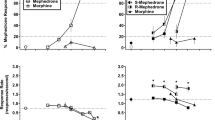Summary
Rats were trained to perform a conditioned avoidance response to white noise in a conventional two-compartment “shuttle-box”. The partition between the compartments had two openings, however, and the correct passage (leftor right) was signalled by changes in background illumination. In this situation the psychotomimetic compoundsd-amphetamine (4 mg kg−1 IP) and phencyclidine (PCP) (2 mg kg−1 SC) were found to selectively disrupt the visual discrimination. Thed-amphetamine-induced abnormal behavior in this situation has previously been linked to excessive dopamine (DA) receptor stimulation, not controlled by nerve impulse flow and its regulation by important local feed-back mechanisms. Thus, the psychotomimetic effects produced by this compound should not only by due to increased DA receptor activationper se, but also to a disruption of normal patterns of firing and release in dopaminergic neurons. There is evidence to suggest that PCP via an excitatory amino acid (EAA) receptor produces a similar net effect on brain meso-limbic dopaminergic neurotransmission via an increased rate of firing, accompanied by regularization of firing (loss of burst activity). In support for a mediation of PCP-induced effects via EAA receptors, the local application of kynurenic acid into the ventral forebrain (4.7µg, bilaterally) was found also to produce a selective disruption of discriminative performance. It should be noted, however, thatd-amphetamine-induced loss of discriminative behavior, but not that induced by PCP, was antagonized by haloperidol (0.1–0.2 mg kg−1 IP) administration. It is thus possible that at least some effects of PCP in this situation are mediated on the efferent side of the dopaminergic neuron. It is suggested that the abnormal behavior, as evidenced by a loss of discriminative (but not avoidance) behavior, is due to disruption of normal, feed-back regulated, nerve impulse flow.
Similar content being viewed by others
References
Ahlenius S (1974) Neuropharmacol 13: 729–739
Ahlenius S (1974) Psychopharmacol 39: 199–212
Ahlenius S, Anden N-E, Engel J (1971) Physiol Behav 7: 931–934
Ahlenius S, Anden N-E, Engel J (1973) Brain Res 62: 189–199
Ahlenius S, Archer T (1985) In: Gilles R, Balthazart J (eds) Neurobiology. Springer, Berlin Heidelberg New York Tokyo, pp 329–343
Ahlenius S, Carlsson A, Engel J (1975) J Neural Transm 36: 327–333
Ahlenius S, Engel J (1975) J Neural Transm 36: 43–49
Ahlenius S, Engel J (1976) Psychopharmacol 49: 63–68
Anden N-E, Carlsson A, Häggendal J (1969) Annu Rev Pharmacol Toxicol 9: 119–134
Andreasen NC, Olsen S (1982) Arch Gen Psychiat 39: 789–794
Balster RL (1987) In: Meltzer HY (ed) Psychopharmacology: the third generation of progress. Raven Press, New York, pp 1573–1579
Bunney BS, Walters JR, Roth RH, Aghajanian GK (1973) J Pharmacol Exp Ther 185: 560–571
Carlsson A (1965) In: Eichler O, Farah A (eds) Handbook of experimental pharmacology. Springer, Berlin Heidelberg New York, pp 529–592
Carlsson A (1988) Neuropsychopharmacol 1: 179–186
Carlsson M, Carlsson A (1990) TINS 13: 272–276
Corrodi H, Fuxe K (1967) Life Sci 6: 1345–1350
Corrodi H, Fuxe K, Hökfelt T (1966) Life Sci 5: 605–611
Cotman CW, Monaghan DT (1987) In: Meltzer HY (ed) Psychopharmacology: the third generation of progress. Raven Press, New York, pp 197–210
Ericson E, Ahlenius S (1990) Psychopharmacol 102: 171–174
Ericson E, Svensson TH, Ahlenius S (1990) Pharmacol Biochem Behav 37: 843–845
Fischman MW (1987) In: Meltzer HY (ed) Psychopharmacology: the third generation of progress. Raven Press, New York, pp 1543 -1553
Gonon FG (1988) Neurosci 24: 19–28
Gonon FG, Buda MJ (1985) Neurosci 14: 765–774
Grenhoff J, Tung C-S, Svensson TH (1988) Acta Physiol Scand 134: 567–568
Grenhoff J, Ugedo L, Svensson TH (1988) Acta Physiol Scand 134: 127–132
Johnson KM, Jones SM (1990) Annu Rev Pharmacol Toxicol 30: 707–750
Kehr W (1976) Drug Res 26: 1086–1088
Li CC (1964) Introduction to experimental statistics. McGraw-Hill, New York
Löffelholz K, Muscholl E (1970) Naunyn-Schmiedeberg's Arch Pharmacol 266: 393–394
Luby ED, Cohen BD, Rosenbaum G, Gottlieb JS, Kelley R (1959) Arch Neurol Psychiatry 81: 363–369
Luby ED, Gottlieb JS, Cohen BD, Rosenbaum G, Domino EF (1962) Am J Psychiatry 119: 61–67
Malmfors T (1965) Acta Physiol Scand 64S248: 1–93
Moore KE, Dominic JA (1971) Federation Proc 30: 859–870
Obianwu HO (1969) Acta Physiol Scand 75: 102–110
Obianwu HO (1969) Acta Physiol Scand 75: 92–101
Olney JW (1990) Annu Rev Pharmacol Toxicol 30: 47–71
Pawlowski L, Mathe JM, Svensson TH (1990) Acta Physiol Scand 139: 529–530
Randrup A, Munkvad I (1969) Ann NY Acad Sci 159: 928–938
Sass H (1989) Br J Psychiat 155 [Suppl]7: 26–30
Seiden LS, Dykstra LA (1977) Van Nostrand Reinhold Co, New York
Siegel S (1956) Nonparametric statistics for the behavioral sciences. McGraw-Hill, New York
Smith AD, Winkler H (1972) In: Blaschko H, Muscholl E (eds) Handbook of experimental pharmacology. Springer, Berlin Heidelberg New York, pp 538–617
Sutherland NS, Mackintosh NJ (1971) Academic Press, New York
van OrdenIII LS, Bensch KG, Giarman NJ (1967) J Pharmacol Exp Ther 155: 428–439
von Voigtlander PF, Moore KE (1973) J Pharmacol Exp Ther 184: 542–552
Zetterström T, Sharp T, Ungerstedt U (1986) Eur J Pharmacol 132: 1–9
Author information
Authors and Affiliations
Rights and permissions
About this article
Cite this article
Ahlenius, S., Ericson, E. & Svensson, T.H. Specific effects by the psychotomimetic drugsd-amphetamine and phencyclidine on the performance of an aversely motivated successive visual discrimination in the rat. Amino Acids 3, 69–79 (1992). https://doi.org/10.1007/BF00806009
Received:
Accepted:
Issue Date:
DOI: https://doi.org/10.1007/BF00806009




